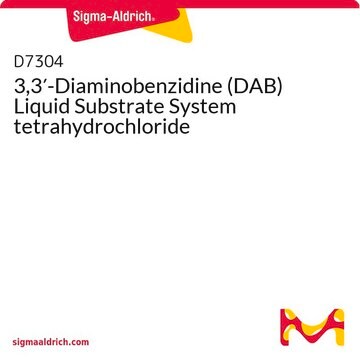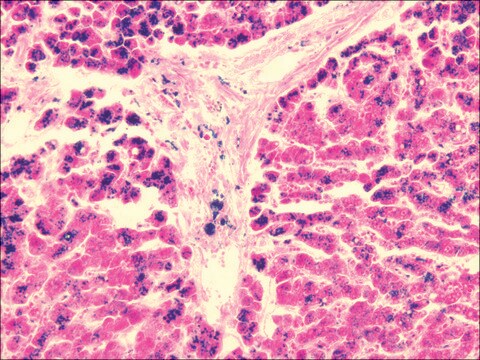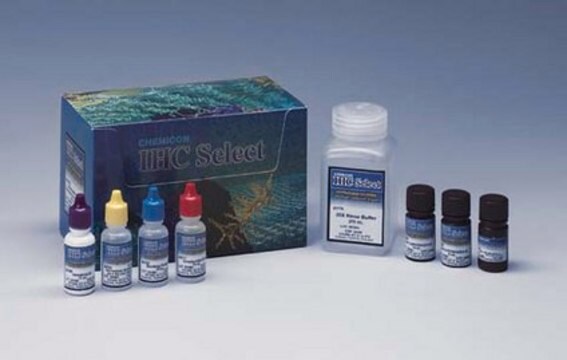11718096001
Roche
DAB Substrate
dark brown, /black precipitate; Visually evaluated
Sinonimo/i:
3,3′-diaminobenzidine tetrahydrochloride, DAB
Autenticatiper visualizzare i prezzi riservati alla tua organizzazione & contrattuali
About This Item
Codice UNSPSC:
12352204
Prodotti consigliati
Produttore/marchio commerciale
Roche
Livello qualitativo
Colore
dark brown, /black precipitate; Visually evaluated
Temperatura di conservazione
−20°C
Descrizione generale
The metal enhanced DAB Substrate utilizes cobalt chloride and nickel chloride in a special formulation to produce a dark brown/black precipitate in the presence of horseradish peroxidase (HRP).
3, 3′ diaminobenzidine tetrahydrochloride (DAB) is a carcinogen that should be used safely. It is one of the major sensitive substrates for HRP (horseradish peroxidase). DAB is brown or amber in color and becomes insoluble and precipitates over the antigen-antibody site due to the presence of hydrogen peroxide and peroxidase.
3, 3′ diaminobenzidine tetrahydrochloride (DAB) is a carcinogen that should be used safely. It is one of the major sensitive substrates for HRP (horseradish peroxidase). DAB is brown or amber in color and becomes insoluble and precipitates over the antigen-antibody site due to the presence of hydrogen peroxide and peroxidase.
Applicazioni
- DAB Substrate is a color sustrate for peroxidases and is used in a variety of applications:Immunohistocytochemistry
- In situ hybridization
- Western blot
- Dot blot
DAB substrate has been used in immunofluorescence and western blot.
Confezionamento
1 set containing 2 components.
Nota sulla preparazione
Working solution:
Storage conditions (working solution): 2 to 8 °C
For best results, store the working solution at 2 to 8 °C when not using.
- Determine the volume of substrate required for the development of peroxidase.
- Remove the DAB/metal concentrate (10x) from -15 to -25 °C storage.
Note: Do not bring to 15 to 25 °C. - Dilute the DAB/metal concentrate (10x) with the peroxide buffer to a 1x working solution. For example, if 5 ml of substrate are required, dilute 500 μl of the DAB/metal concentrate (10x) with 4.5 ml of the Peroxide buffer.
- Mix well.
- Add the 1x working solution to the tissue or blot until desired substrate development.
Note: The 1x solution is stable over many hours.
For best results, store the working solution at 2 to 8 °C when not using.
Storage conditions (working solution): 2 to 8 °C
For best results, store the working solution at 2 to 8 °C when not using.
Altre note
For life science research only. Not for use in diagnostic procedures.
Solo come componenti del kit
N° Catalogo
Descrizione
- DAB/metal concentrate, 25 ml 10x concentrated
- Peroxide Buffer, 250 ml
Avvertenze
Danger
Indicazioni di pericolo
Classi di pericolo
Acute Tox. 3 Dermal - Acute Tox. 3 Inhalation - Acute Tox. 4 - Aquatic Chronic 2 - Carc. 1A - Carc. 1B - Flam. Liq. 2 Oral - Repr. 1B - Skin Sens. 1 Inhalation - STOT RE 2 - STOT SE 1
Codice della classe di stoccaggio
3 - Flammable liquids
Classe di pericolosità dell'acqua (WGK)
WGK 3
Scegli una delle versioni più recenti:
Possiedi già questo prodotto?
I documenti relativi ai prodotti acquistati recentemente sono disponibili nell’Archivio dei documenti.
I clienti hanno visto anche
The developmental origin of zygodactyl feet and its possible loss in the evolution of Passeriformes.
João Francisco Botelho et al.
Proceedings. Biological sciences, 281(1788), 20140765-20140765 (2014-06-27)
The zygodactyl orientation of toes (digits II and III pointing forwards, digits I and IV pointing backwards) evolved independently in different extant bird taxa. To understand the origin of this trait in modern birds, we investigated the development of the
Pathobiology of Human Disease: A Dynamic Encyclopedia of Disease Mechanisms (2014)
Adrenergic Receptor Protocols (2000)
The developmental origin of zygodactyl feet and its possible loss in the evolution of Passeriformes.
Botelho J F, et al.
Proc. Royal Soc. Lond. B., 281(1788), 20140765-20140765 (2014)
Principles and Reactions of Protein Extraction, Purification, and Characterization (2005)
Il team dei nostri ricercatori vanta grande esperienza in tutte le aree della ricerca quali Life Science, scienza dei materiali, sintesi chimica, cromatografia, discipline analitiche, ecc..
Contatta l'Assistenza Tecnica.










